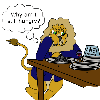|
Eat and be eaten: Food chains
 In
nature, short-term survival depends mainly on the organism finding sufficient
food for its needs, and preventing itself becoming dinner for something
else. In
nature, short-term survival depends mainly on the organism finding sufficient
food for its needs, and preventing itself becoming dinner for something
else.
Animals will choose and prefer foods which are for them easily caught,
palatable and of a suitable size for eating. The food must provide more
energy than is expended in its hunting, capture and eating. For example,
a lion eats large prey such as zebra or young elephant, not ants, whereas
a spider may eat tiny prey such as flies.
Food chains
A food chain is a simple, graphic way of showing
a food relationship between organisms. It shows how energy and nutrients
are transferred from plants (producers) to herbivores and carnivores
and through to decomposers.
All food chains start with a producer. The arrows in the food chain
below depict the direction in which energy and nutrients flow, i.e.
the arrow always points from the eaten to the eater.
Here is an example of a food chain:
| Grass |
 |
grasshopper |
 |
field mouse |
 |
snake |
 |
owl |
The grass is the producer. It makes sugars using carbon dioxide, water
and sunlight, and then uses other minerals from the soil to convert
these into proteins and other organic substances.
The first consumer is always a herbivore (in this instance, the grasshopper)
and it is called a first order consumer, with successive members of
the food chain being called in turn second, third and fourth order consumers
(field mouse, snake, owl).
 Affecting
the food chain Affecting
the food chain
Improved environmental conditions (more rain, adding fertilisers, fencing
off kangaroos, and so on) will increase the amount of grass, providing
food for increased numbers of grasshoppers, and then more food for all
higher order consumers in the chain. Conversely, a mouse eradication
program would also decrease the snake and owl populations unless they
have alternate food sources.
Any break in the food chain will have repercussions at all higher levels
of the chain (for example, starvation) as well as resulting in higher
numbers at the lower levels of the chain (because they are not being
eaten).
More food chains
Pond:
| Algae |
 |
water beetle |
 |
dragonfly nymph |
 |
fish |
 |
heron |
(pond slime)
Sea:
| Phytoplankton |
 |
small crustaceans |
 |
fish |
 |
dolphins |
 |
|
killer whale |
(microscopic plants)
Human:
| Algae |
 |
tadpole |
 |
small fish |
 |
Murray cod |
 |
human |
Energy in the food chain
At each level in the food chain, energy is used up by the organism's
life functions such as growing, moving and so on. This energy is ultimately
lost as heat to the environment, which means it is unavailable to organisms
at the next level in the food chain. Because of this progressive loss
of energy, food chains are rarely more than 6 members long.
It is less wasteful of energy for humans to eat producers such as grains,
fruit and vegetables, than to eat consumers such as meat, fish and eggs.
In third world famine situations, therefore, eating meat is a luxury.
Food webs
 In nature, feeding relationships are more complex. Most consumers
eat several different foods, and are in turn eaten by many different
higher-order consumers.
In nature, feeding relationships are more complex. Most consumers
eat several different foods, and are in turn eaten by many different
higher-order consumers.
By convention, decomposers are usually left out of food chains because
they eat everything in the end.
|